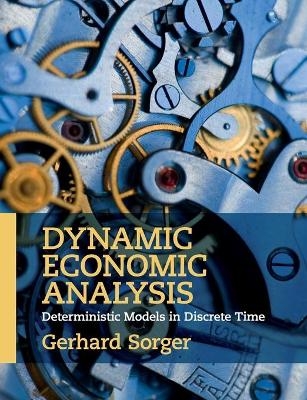
Dynamic Economic Analysis
Deterministic Models in Discrete Time
Seiten
2015
Cambridge University Press (Verlag)
978-1-107-44379-2 (ISBN)
Cambridge University Press (Verlag)
978-1-107-44379-2 (ISBN)
For advanced students in economics, this textbook provides a clear and concise introduction to dynamic economic theory and analysis. Sorger guides students step-by-step through the most popular model structures and solution concepts, from the simplest dynamic economic models to complex problems of dynamic general equilibrium frameworks.
Focusing on deterministic models in discrete time, this concise yet rigorous textbook provides a clear and systematic introduction to the theory and application of dynamic economic models. It guides students through the most popular model structures and solution concepts, from the simplest dynamic economic models through to complex problems of optimal policy design in dynamic general equilibrium frameworks. Chapters feature theorems and practical hints, and seventy-five worked examples highlight the various methods and results that can be applied in dynamic economic models. Notation and formulation is uniform throughout, so students can easily discern the similarities and differences between various model classes. Chapters include more than sixty exercises for students to self-test their analytical skills, and password-protected solutions are available for instructors on the companion website. Assuming no prior knowledge of dynamic economic analysis or dynamic optimization, this textbook is ideal for advanced students in economics.
Focusing on deterministic models in discrete time, this concise yet rigorous textbook provides a clear and systematic introduction to the theory and application of dynamic economic models. It guides students through the most popular model structures and solution concepts, from the simplest dynamic economic models through to complex problems of optimal policy design in dynamic general equilibrium frameworks. Chapters feature theorems and practical hints, and seventy-five worked examples highlight the various methods and results that can be applied in dynamic economic models. Notation and formulation is uniform throughout, so students can easily discern the similarities and differences between various model classes. Chapters include more than sixty exercises for students to self-test their analytical skills, and password-protected solutions are available for instructors on the companion website. Assuming no prior knowledge of dynamic economic analysis or dynamic optimization, this textbook is ideal for advanced students in economics.
Gerhard Sorger is Professor of Economics at the University of Vienna, Austria where he teaches primarily in the areas of macroeconomics, mathematical economics, and dynamic economic analysis.
Preface; Part I. Difference Equations: 1. Basic concepts; 2. Linear difference equations; 3. Autonomous difference equations; 4. One-dimensional maps; Part II. Dynamic Optimization: 5. Optimization techniques; 6. Dynamic inconsistency and commitment; 7. Dynamic games; 8. Dynamic competitive equilibrium; References; Index.
| Erscheint lt. Verlag | 12.2.2015 |
|---|---|
| Zusatzinfo | 30 Line drawings, unspecified |
| Verlagsort | Cambridge |
| Sprache | englisch |
| Maße | 188 x 244 mm |
| Gewicht | 640 g |
| Themenwelt | Mathematik / Informatik ► Mathematik ► Angewandte Mathematik |
| Mathematik / Informatik ► Mathematik ► Finanz- / Wirtschaftsmathematik | |
| Wirtschaft ► Volkswirtschaftslehre ► Ökonometrie | |
| ISBN-10 | 1-107-44379-2 / 1107443792 |
| ISBN-13 | 978-1-107-44379-2 / 9781107443792 |
| Zustand | Neuware |
| Haben Sie eine Frage zum Produkt? |
Mehr entdecken
aus dem Bereich
aus dem Bereich
Buch | Softcover (2024)
Springer Vieweg (Verlag)
CHF 62,95
Anwendungen und Theorie von Funktionen, Distributionen und Tensoren
Buch | Softcover (2023)
De Gruyter Oldenbourg (Verlag)
CHF 97,90


